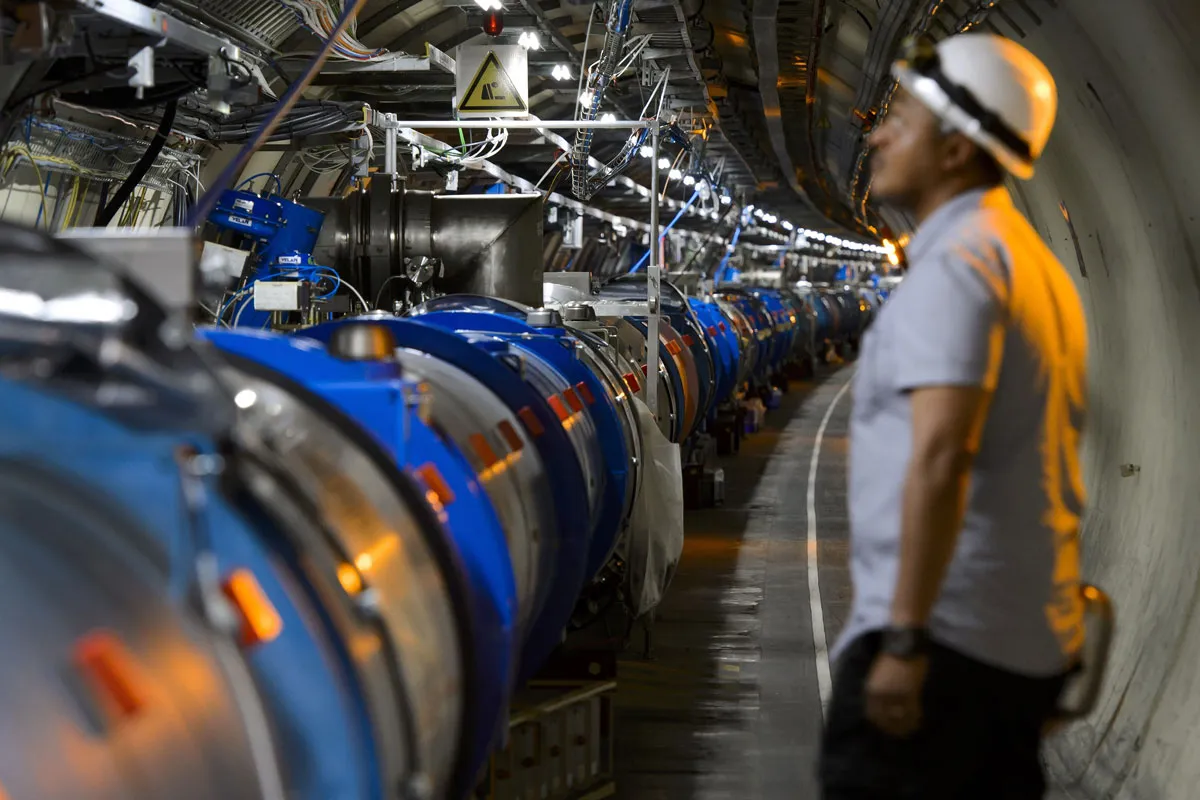No one has ever seen a Higgs boson.
In fact, of all the particles in the Standard Model of Particle Physics – an astonishingly successful and precise theory upon which our entire understanding of particle interactions is based – arguably only the photon (a particle of light) is in any sense visible.
All the other denizens of the Standard Model menagerie – quarks, electrons, mu and tau leptons, neutrinos, gluons, and W and Z bosons – are, for various reasons, effectively invisible to the eye.
As for the Higgs boson, even indirectly inferring its existence took an international 40-year search with the most complex machine ever built by humans.
How the Higgs boson was discovered
Its 2012 discovery at the Large Hadron Collider (LHC) at CERN was considered one of the most important advances of modern physics and a phenomenal success of the Standard Model.
Using a combination of data from the LHC’s giant ATLAS and CMS detectors, the Higgs detection confirmed our picture of how fundamental particles (like quarks and electrons) acquired the properties we measure today, and how the forces of nature arranged themselves in the early Universe.
Now that we have the Higgs, researchers at the LHC have been hoping to use it to better understand the Standard Model itself, or, ideally, find a hint of ‘new physics’ that would indicate what kind of theory might replace it.

But how do we study a particle we can’t see? What are we really looking at? The answers are complicated, but they also touch on something much deeper: the essential entanglement of theoretical models and experimental data.
One problem is that the Higgs doesn’t just exist naturally in the wild, waiting to be captured. If you want a Higgs boson, you have to create one.
Fortunately, subatomic particles can be coaxed to transmute into one another, given the right conditions, based on a complex web of interactions all laid out in the Standard Model.
At the LHC, physicists smash protons together at high speeds, knowing that more energy means more massive particles can appear. Dial the energy up high enough, and some of those will be Higgs bosons.
Production, though, is only half the battle. Once a Higgs is born, it has a lifetime of less than a billionth of a trillionth of a second.
This means that after you’ve gone to all the trouble to create a Higgs boson, it will immediately decay into other particles (again, with rates depending on that complex set of Standard Model rules).
This happens so quickly that even the incredibly fast detector triggers in the LHC couldn’t possibly see it happen.
Standard Model parameters come into both sides of this process: the production of the Higgs, and the way it decays. This is a key aspect of modern physics.
The connection between theory (here, the Standard Model) and experiment (collision and detection) is iterative: the theory tells us what to expect from the experiment, and the experiment helps us refine, or reject, the theory.
Without the experiment, we couldn’t test the theory, but without a theory, the data would mean nothing.
Our first experimental glimpse of the Higgs came from two distinct signatures. One was pairs of high-energy photons, each carrying off half the energy of the (suddenly decayed) Higgs particle.
The other was even less direct: the Higgs decayed into other unstable particles that themselves decayed into longer-lived particles, which could in turn survive long enough to be detected by the ATLAS and CMS detectors.
It’s tempting to think about particle detectors as traps, capturing particles to be poked and prodded. But across experimental physics, detecting particles is more about examining the kinds of interactions that can occur between our target particles and the ones our machines can work with (primarily: photons, electrons, and muons).
Even these more accessible particles are not seen directly, but instead trigger specialised detectors, which count up the number and energy of the particles they detect.
At every point, experimentalists must contend with ‘backgrounds’ – detector triggers due to a confusing shower of particles unrelated to the ones they’re looking for.
How recent Higgs boson discoveries have created more mysteries
In May, LHC scientists announced that they had seen, for the first time, evidence of the Higgs decaying into a photon and a Z boson (a particle that carries the weak nuclear force).
Intriguingly, signs of this rare decay were seen about twice as often as predicted, which could indicate that the web of interactions might need to be revised to include some new particles not currently part of the Standard Model.
As we dig deeper into the workings of fundamental physics, with ever more powerful experiments, we will continue to find ourselves relying on methods that seem to be increasingly removed from directly ‘seeing’ what’s happening.
This means finding new ways to tease a tiny effect out of a background of complicated noise, including (as in the rare decay measurement) using methods such as machine learning to help.
The ancient Greek physicist/mathematician Archimedes once said that with a lever long enough, he could move the world. The LHC is perhaps the longest lever we’ve ever built, linking together an increasingly complex set of experimental and theoretical tools to uncover the fundamental workings of our Universe.
Read more about physics: